With modern architecture comes the innovation offered by keystone wall plates as a type of infrastructure. These plates serve a variety of needs, suited for everything from home theaters and office networks to far more extensive AV setups. Beyond management, they provide a professional aesthetic and effortless configurability. This guide looks into the merits of keystone wall plates, their mechanics, and how one can select the best options for their needs. You will understand why these modular devices have become essential in domestic and commercial settings alike.
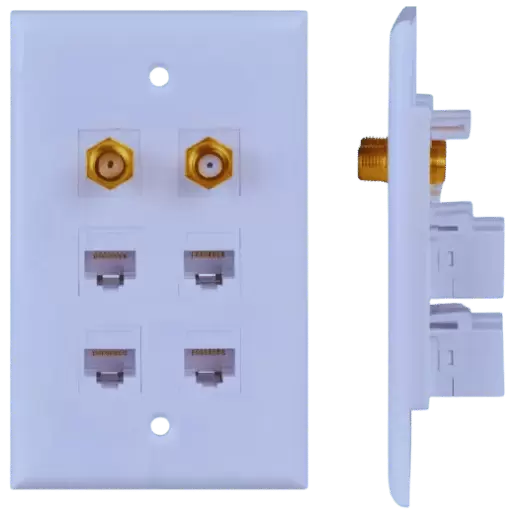
A keystone wall plate is a type of wall plate that seamlessly integrates with other data wall plates and mounting boxes, allowing for full customization with cables such as Ethernet, HDMI, USB, or audio. Its value lies in the organization it brings to a complex wiring setup, preserving aesthetics, cleanliness, and professionalism, while allowing for future changes. Nowadays, keystone wall plates have found application in homes as well as in offices and commercial centers for decorative as well as organizational purposes.
Keystone wall plates acts as modular systems intended to house various interchangeable keystone jacks for networking, audio, video, and other gadget connections. These wall plates improve organization by enabling different port configurations to address distinct connectivity needs. The modularity and compatibility of these wall plates make them practical for organizing cables and providing neat installations in homes and offices.
In contemporary connectivity systems, keystone jacks provide connectivity along with a uniform standard interface for various types of cabling. These jacks form a part of structured cabling system, facilitating Ethernet networks as well as telephonic lines, audio visual systems, etc. Keystone jacks can be placed into modular wall plates, surface mount boxes as well as patch panels. In case of damage to the computer network, these jacks make maintenance easier and quicker, reducing the work needed in both residential and commercial spaces.
The most recent improvements made to the technology of keystone jacks focus on modifying the data transfer rates and the future adaptability of the system. For instance, Category 6A keystone jacks, which are used in data centers, support data speed of up to ten gigabits per second, the same as high definition video data streams. Furthermore, shielded keystone jacks are more resistant to electromagnetic interference (EMI), enabling better signal quality where interference is high, such as industrial or heavily wired locations.
In addition, keystone jacks assist in streamlining cable organization. Their modular design permits swift deployment and replacement, while color-coded or labeled ports facilitate troubleshooting and organization. Recent industry analysis indicates that the global structured cabling market, which incorporates keystone jacks as a fundamental component, is expected to expand at a compound annual growth rate (CAGR) of 9.1% from 2023 to 2030. This is fueled by the demand for high-speed connections, smart homes, and expansive enterprise-level networks.
Keystone jacks maintain their position as foundational elements in constructing robust and versatile connectivity solutions systems due to their unmatched versatility, compatibility, and scalability.
In homes and workplaces, wall plates serve as important tools that keep things organized and all connections managed. These plates offer a neat and safe demarcation for different types of cabling like Ethernet, coaxial, HDMI, and USB. Moreover, wall plates also allow for an orderly professional image by securing keystone jacks and cable terminations which minimizes cable damage alongside accidental removal.
As for home settings, they also aid in supporting modern smart home systems. With the advent of Internet of Things (IoT) globalisation, wall plates containing Ethernet or HDMI ports allow effortless links for automation systems, streaming gadgets, and entertainment systems. A good example is where they are increasingly preferred, like in home offices or media rooms which require reliable and high-speed wired internet through Ethernet services, thus making Ethernet wall plates highly sought after since they are better than wireless options.
In an office setting, wall plates help optimize the enterprise cabling system. They are used in meeting rooms, workstations, and server rooms to enable efficient connections to computers, VoIP phones, and other peripherals. For instance, structured cabling systems employing Ethernet wall plates provide reliable data transfer and minimize network-related interruptions. As market research indicates, the supply of sophisticated cabling strategies designed to improve office efficiency is expected to increase significantly along with the rate at which companies seek to expand their digital functionalities.
Wall plates are crucial in any network design due to their ability to accommodate different keystone jacks. In domestic and commercial settings, wall plates meet modern requirements for connectivity that are aesthetic, lasting, and adaptable.
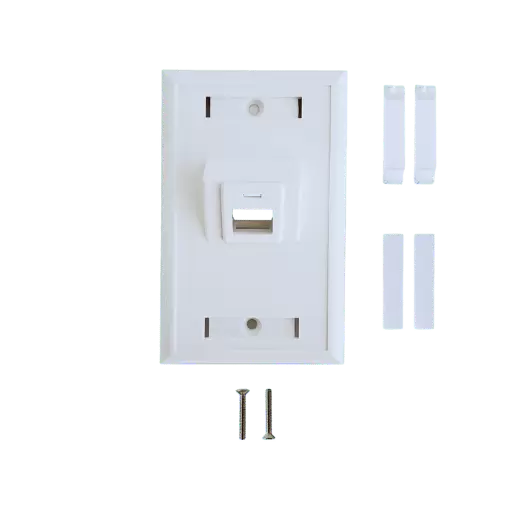
1. Wall Plate Port Density Considerations
The density of ports on the wall plate you select is primarily affected by the number of keystone jacks needed. For simpler configurations, single-port wall plates are efficient; however, larger setups like business offices or server rooms require multi-port wall plates. For example, in network configurations with a large number of devices, 6-port and 12-port wall plates are frequently used to optimize connectivity.
2. Ensure Compatibility with the Selected Keystone Jacks
While selecting a keystone wall plate, ensure that it is aligned with and compatible with the jacks being used. Some of the most common keystone jacks used are Ethernet (RJ45), coaxial, HDMI, and USB jacks. The wall plate also needs to match the height, breadth, and cut-outs for the kinds and sizes of jacks used to prevent ill-fitting parts, which can cause diminishing efficiency. The wall plate should also be designed to enhance the performance of the whole system. Hence, all required parameters must be checked and provided at the design stage.
3. Durability of the Material and Resistance to Fire
Wall plates constructed using polycarbonate or ABS plastics are comparatively easier to damage and wear and tear, in addition to their fire-resistant capabilities. Moreover, polycarbonate materials contribute to impact resistance. Due to advancements in technology, modern wall plates also conform to industry standards for retardants of fire, improving safety in residences and businesses. For example, UL94 flame-resistant guaranteed materials are frequently suggested.
4. The Balance of Beauty and Utility
Wall plates must match the aesthetic components of the artwork in the space. With a wide range of colors and finishes, options are driven by both aesthetics and functionality. Offices tend to take neutral, professional colors, while decorative options are available for home installations.
5. Identification for Order
Labeling solutions are critical for cable management in complex systems. Wall plates that offer integrated labeling or label areas enhance network troubleshooting and maintenance efforts. Visible identification is essential for effective label management in intricate systems.
6. Compliance and Warranty
Select wall plates and keystone jacks marked with certifications, such as the TIA/EIA-568 or ISO/IEC 11801, to guarantee a reliable network infrastructure while optimally connecting various systems. Certified products are marked to show verifiable compliance with established norms.
Taking these recommendations improves network efficiency as well as operational lifetime by meeting all wall plate functional and design considerations at the same time.
It is important to note the distinctions in size, application, as well as overall capacity when choosing between single-gang and double-gang wall plates. A single gang wall plate caters to one compartment, which is designed for one outlet, switch, or low voltage component. These plates measure around 2.75 inches in width and thus are built for spaces with minimal wiring needs or constricted spaces where installation is required.
Double gang wall plates, as the name suggests, have two compartments that allow more connections and switches to be facilitated. Measuring roughly 4.5 inches, these plates are more suitable for installations that have higher demand and require both power and network ports to be accommodated side by side. Double gang wall plates are often preferred in commercial environments or home theaters where multiple connections are essential.
Recent data indicates that the typical usage scenarios for single-gang plates include residential light switches, single Ethernet jacks, or single power outlets, while double-gang plates are increasingly implemented for configurations supporting dual power outlets or combinations of electrical and low-voltage devices. The proper selection from these two plates is dictated by the technical requirements of the project, device layout, and aesthetic preferences.
About ivory and other color selections, aesthetic considerations fall within the scope of both Intended impact and peripheral decor. Ivory has a lasting and neutral appeal, as it works with almost all designs, whether modern or traditional. However, some colors like white, black, or metallic can be used for striking decor contrast or for amalgamating specific design facets. Overall, my preeminent focus is on colors that promote spatial cohesion guided by the design objectives’ functional and stylistic aims.
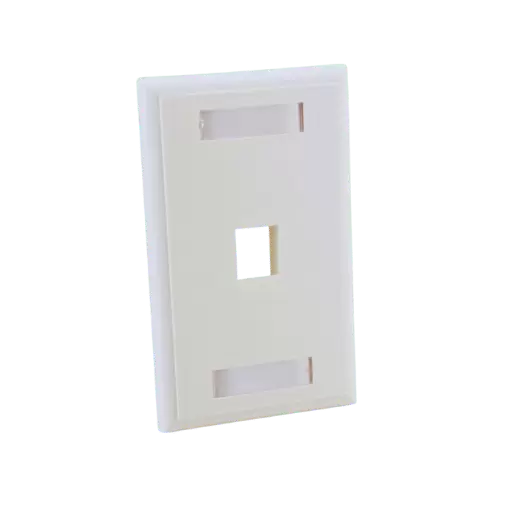
The Keystone wall plates have been designed to accommodate a specific number of ports, consequently determining the number of modules or connectors that may be installed.
Choosing the optimal configuration is based on the needs of the AV or network infrastructure in question, which achieves the needed results without an excess of clutter.
Modular Wall Plates
Not only are these plates aesthetically pleasing, but modular wall plates also solve a variety of connector types and configurations with maximum versatility. Customization is achieved through the integration of insert modules that address precise network, AV, or power needs. These are most suited for dynamically changing environments such as a modern office, data center, or smart home where requirements reorganize themselves periodically. For example, these plates can support HDMI, Ethernet, USB, and coaxial inputs by adding or swapping out modules. Modular wall plates significantly improve long-term adaptability and scalability by reducing overhauls of wall plates that are required when new connections are added or upgrades are made.
Moreover, modular plates improve the overall aesthetic of an installation by reducing visual clutter while maintaining order. Multiple functionalities can be achieved with fewer plates. Research on connectivity solutions indicates modular plates are efficient in network elasticity and ease of maintenance.
Standard Wall Plates
As for standard wall plates, they have a fixed layout that is customized to specific scenarios. They are usually readily available, cut for basic connections like electrical sockets or single Ethernet ports. Since no additional pieces are required, these are often cheaper and simpler to install. Standard plates excel in environments with static needs, such as residential homes or simpler office spaces that do not require complex configurations, where connection needs are stable and infrequent changes are expected. For enhanced durability as well as compatibility with the environmental conditions of the installation site, several materials, including plastic, stainless steel, and certain metal alloys, are used.
Key Differences and Selection Guidelines
While modular plates allow greater customization, their higher initial cost, along with needing to be integrated by a trained professional, increases their overall cost. For environments with simpler setups where cutting costs is essential, standard plates are the better option, albeit lacking flexibility for future alterations. Environments that prioritize modularity and advanced technology upgrades will benefit from the modular plates more. Contrarily, long-term applications that expect stability regarding the connection configurations will find standard wall plates simpler and more advantageous.
Selecting modular or standard wall plate options requires one to evaluate the system’s actual and future requirements. By aligning the type of plate with operational functional requirements, users work towards achieving optimum, efficient, aesthetic, and economical solutions.
It’s crucial to look at both functional and aesthetic needs of the space when choosing between flush and snap-in styles for wall plates. Flush wall plates are intended to be at the same level with the wall surface and therefore have a sleek look. These plates are very appropriate for modern interiors or areas where space restrictions are a major concern, such as commercial offices or residences with contemporary architecture. Moreover, these plates are preferred for areas where dirt accumulation is a problem because their configuration minimizes edge accumulation.
In contrast, snap-in wall plates are flexible and very easy to use. These plates contain inserts which are removable, and this makes it easier for technicians to reconfigure or replace parts without removing the entire assembly. This makes the snap-in style most suited for data centers, conference rooms or multimedia arrangements that need constant rearrangement of connections or in dynamic spaces. Research shows that snap-in styles are increasingly being adopted in professional IT environments due to their modular design and broad range of compatible ports and connectors.
Flush and snap-in styles should, after all, strike a balance between the aesthetic appeal and installation complexity of the workspace while guaranteeing efficiency and satisfaction.
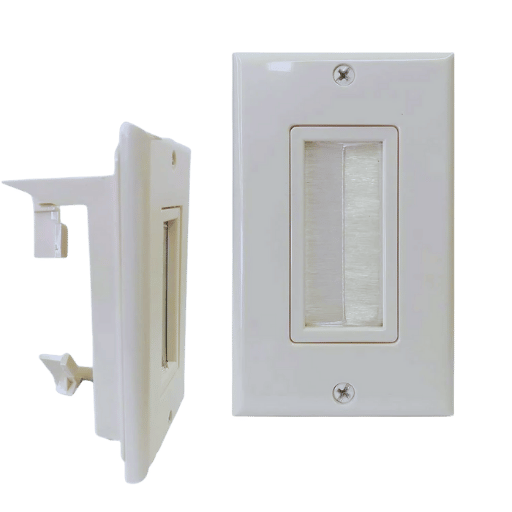
Gather All Required Tools and Materials
To guarantee discreet installations, begin by gathering a screwdriver, punch down tool, wire stripper, and cable tester. Furthermore, ensure that you possess the appropriate keystone jacks and wall plates that are compatible with your system and cables.
Plan for the Layout and Compatibility Check
As with all installation designs, define the installation area while considering if the wall plate will fit into the designated area, and determine whether the network needs shall be fulfilled. Depending on the performance needs, compatibility with Category 5e, 6, or 6A cables is required. Category 6A cables are now regarded as the preferred choice for high-performance networks since they support industry-standard speeds of 10 Gbps over 100 meters.
Cable Preparation and Jack Affix
Cable couplings should be prepared such that they offer the needed cable lengths after consideration for possible adjustments. Cut 1-2 inches of the jacket to receive the cable while retaining the twisted wire pairs. Affix the wire pairs to the keystone jack per the wiring standard used, whether T568A or T568B. This guarantees compliance with professional wiring standards, which provides reliable performance as well as traceable fault diagnosis.
Punch Down the Wires
Use the punch down tool to fasten each wire to the keystone jack, placing them securely. Check that all connections are smooth and there are no exposed wires or loose connections. Termination that is not properly performed might cause interference or signal degradation affecting the network performance.
Install the Keystone Jacks Into the Wall Plate
Ensure the terminated keystone jacks are placed into the wall plate correctly. This serves to guarantee that they snap into the right position, thereby preventing any loose fit that could lead to a counter use.
Mount the Wall Plate
Using screws, fix the wall plate to the gang box or mounting bracket while simultaneously ensuring that it is level and flush with the wall. Achieving an aesthetically pleasing result is best done at this stage.
Test the Connections
Performing a test ensures all ports are operating as they should and are able to transmit data at the required standard. Test the connections to check reliability and performance using a cable tester.
Label and Finish the Installation
For easy identification, each port on the wall plate should be clearly marked according to its defined function or position within the network. This enhances order during future maintenance and upgrades on the network. Ensuring that the setup is completed requires a final check so that all fittings are properly adjusted and look professional.
Meeting contemporary technical requirements is possible by performing these steps with care and detail, which leads to achieving professionalism in the wall plates as well as a clean and operational keystone wall plate installation.
A keystone wall plate installation can be done without a hitch if a suitable set of tools and cables is at hand. The following is a comprehensive list of the various tools and types of cables that would make the installation process effortless:
Tools
Required Wiring
Other Important Details
Ensure that the selected wires meet the ANSI/TIA requirements for standards coping with structured cabling systems and are rated for in wall installation. If the wires run through air ducts, or spaces that need fire resistant material, then plenum rated cables may be required. Sticking to the guidelines will guarantee optimal performance alongside safe operation.
Loose Connections
Cable Miswiring
Bent Or Damaged Pins
Excessive cable length can adversely impact systems
Environmental Interference
Worn Cables
Jack’s Not Mounted Securely
Functionality Issues
These measures can help maintain the integrity and reliability of the network, increasing uptime while minimizing system failure risks. Regular maintenance and rigorous compliance with installation standards will mitigate other issues from recurring.
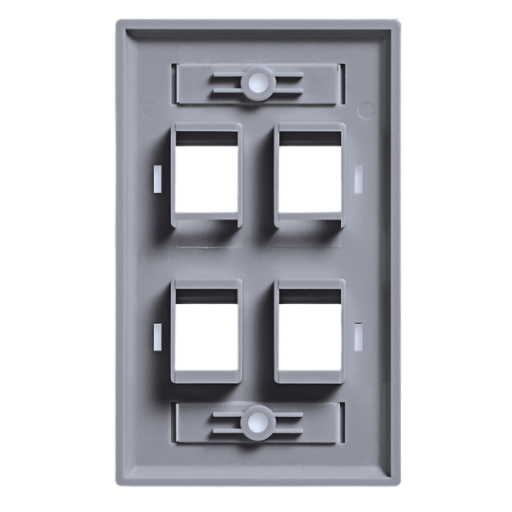
Keystone wall plates allow effective management of connectivity in commercial and residential environments. In commercial applications, these plates are commonly used within structured cabling systems in offices, data centers, and comms rooms to enhance network docking as well as improve the aesthetic order of the entire infrastructure. With keystone modules, it is possible to customize wall plates by adding Ethernet, HDMI, or USB ports to meet business requirements. This enables optimized communication and resource sharing within the business.
For multimedia and particularly network connections, keystone wall plates help to improve organization as well as aesthetic value for residential purposes. Various ports such as cable TV, satellite, and home theater systems can be consolidated to a single wall outlet for simplicity, enabling seamless connectivity for homeowners. Current estimates suggest that residential installations of structured cabling systems will grow at a compound annual rate exceeding 5% up to 2028 as a direct result of the more widespread adoption of smart home technologies. Whether for professional environments or personal spaces, keystone wall plates enable economical customization for connecting multiple devices while optimizing space and improving décor.
The High-Definition Multimedia Interface (HDMI) technology allows an optimal method of interfacing television and audio devices with home theater systems. HDMI 2.1 and its successors will support 4K and 8K, dynamic HDR as well as frame rates of 120 fps, which guarantees an improved viewing experience and more immersive watching with clearer images and vibrant colors. HDMI supported Enhanced Audio Return Channel (eARC) guarantees Dolby Atmos and DTS X compressed audio formats, which require to be decoded before transmission, such as surround sound, perfect for movie watching in homes, allowing for more realistic surround sound architecture.URLure.
Market analysis shows that the previously stated factors explain the growing adoption trends of HDMI 2.1 devices. Further, 4K television shipments are predicted to exceed 200 million by 2025, reflecting the demand for high-quality displays. HDMI has the ability to connect many other components which including projectors and AV receivers, which reduces complexity and maintains the quality of the signals relayed. Using HDMI technology in integrating entertainment systems improves performance and is appropriately implemented for anticipated technologies.
For high-speed network applications and complex configurations, the performance of the network heavily depends on how Cat6 cables and RJ45 connectors are configured and organized. The following details explain configurations and other considerations:
Rules on Cable Termination
Shielded vs. Unshielded (STP/UTP)
Considerations Regarding Cable Length
Support of Bandwidth
Regardless of the type of installation, Cat6 cables support a minimum of 250 MHz bandwidth which provides optimal performance for intensive data operations such as video communication, server communication, and much more. Maximal performance on these operations requires proper termination and installation.
Integration of Keystone Jack with the Patch Panel
Cross-Connector Use
Only use quality RJ45 connectors with Cat6 rating alongside vital shielded dry-stranded patch cords and patch panels for optimal performance. Using standard RJ45 will lead to poor network speeds due to inadequate bandwidth support.
Validation and Testing
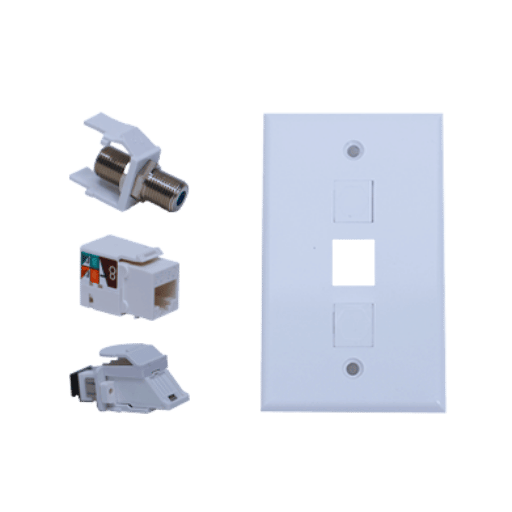
A: A keystone wall plate is a custom faceplate that accepts multiple keystone inserts. It can hold Ethernet, HDMI, and fiber optic connectors. These are used in homes or offices to configure data communication systems and to communicate in general.
A: The selection of an appropriate keystone insert is based on the specific data communication requirements of the user. Consider the types of connectors needed – whether ethernet or fiber – as well as the quantity of ports desired, which may range from 2-port, 3-port, or 6-port inserts.
A: Keystone wall plates are compatible with standard keystone inserts which means they accommodate Ethernet, fiber, and HDMI types of connections. However, you should check that the insert matches the wall plate you intend to use prior.
A: Having an ID window on a keystone wall plate allows for simple tagging and recognition of each port, which is beneficial in multi-connection settings like commercial and industrial spaces.
A: Certainly. There are keystone wall plates that accept connections for fiber optics. A compatible fiber optic keystone insert must be used to ensure proper connectivity.
A: The term single-gang keystone wall plate applies to the single gang size of the wall plate keystone. It is a single gang product meaning it is fit for a single standard electrical box where a certain number of keystone inserts, say 2 port or 3 port, can be inserted.
A: Keystone wall plates vary in the number of ports they can have, from a simple 2-port design to a sophisticated 12-port design. The number of ports will primarily depend on the size and design of the faceplate selected.
A: Certainly. Custom cable assemblies can be integrated with keystone wall plates to ensure all your requirements in networking and connectivity are perfectly met whether at the home or in the office.
A: Mounted keystone wall plates are affixed by screws placed in the standard holes found on electric boxes or surface mount boxes and attached to the surface. This affixes the wall plates firmly while allowing them to be positioned conveniently for use with the connectors.
1. Title: Gravity Shear Load Consideration on Corrugated Steel Plate Shear Walls
Summary:
2. Title: An experimental study of the behavior of corrugated steel shear wall with different angles of trapezoidal plates attached at its angles
Synopsis:
4. HDMI
5. Ethernet